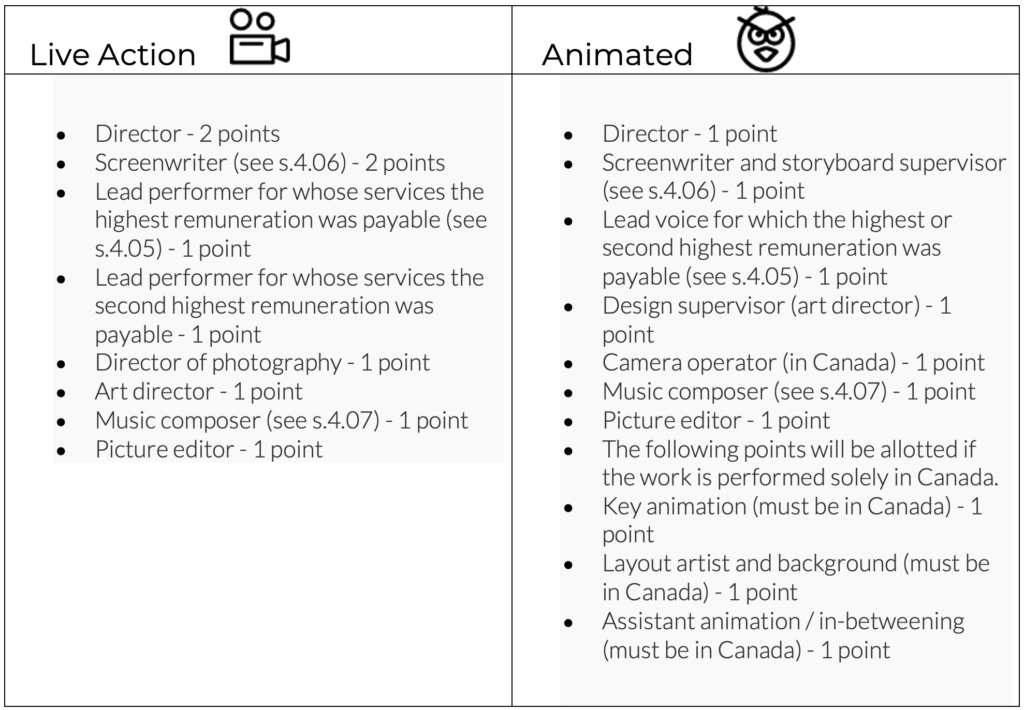Canada Media Fund: Performance Envelope Program – Introduction
Please be advised, in response to the disruption in Canada’s screen-based industries caused by the COVID-19 pandemic, there may be specific exceptions to the following information found in the COVID-19 Flexibility Measures to CMF Programs – 2021-2022.
The Canada Media Fund (“CMF”) is a great way for Canadian television producers to receive financial support for their projects. This series of blogs will discuss the different “programs” under which the CMF distributes funding and what producers must do in order to receive this funding.
The Performance Envelope Program
The CMF offers funding through a variety of “programs” designed to support specific niche areas of production. The majority of CMF funding is given through the Performance Envelope Program (“PEP”). Under the PEP, Canadian broadcasters receive a “funding envelope” from CMF. Broadcasters then allocate the CMF funds to projects they believe will have the greatest market success. Importantly, while the broadcasters determine what projects will receive funding, the actual CMF funds are paid directly to producers.

Join Our Community
Be the first to read new articles, industry news, and more. Sign up to our newsletter today!
PEP Requirements
In order to receive funding under the PEP producers must meet an array of eligibility criteria, which are set out in detail in the CMF Guidelines.
Broadly speaking, in order to qualify, applicants must either be:
- a for-profit production company that is “Canadian-controlled”¹ with its head office in Canada and is in good standing will all applicable talent and industry associations and guilds; or
- a “Canadian Broadcaster”.²
Additionally, all applicants must own and control the rights necessary to produce and exploit the project.
All eligible projects must also be designed for distribution on at least two platforms. One of the platforms must be TV (referred to as the TV Component) and must be made available by one or more Canadian Broadcasters. The second platform may be either a Digital Media Component (a DM Component is defined further below), a TV Component made available to Canadians by one or more Canadian Broadcasters, or a TV Component made available to Canadians by a Canadian entity through non-simulcast digital distribution (which means that the content cannot be made available simultaneously with the television broadcast). It is important to note that a TV Component made available by the same type of Canadian Broadcaster cannot, by itself, satisfy the requirements for both platforms. That is to say, a single component may not be double counted to satisfy the requirement that a program be distributed on at least two platforms.
Both the TV Component and the DM Component (if an applicant has a DM Component) have certain requirements that must be met in order to qualify for funding. This blog will now discuss those requirements.
Canada Media Fund: Performance Envelope Program – TV Component Essential Requirements
CMF’s mandate is to promote Canadian content. As such, CMF requires that the projects it supports are made by Canadians, primarily made for Canadians, and are set in Canada. Each TV Component must meet three “essential” requirements.
First, a TV Component must receive 10 out of 10 points on the CAVCO certification scale.³ Points are awarded for Canadians⁴ who hold key positions in a project, such as director, screen writer, or lead performer. To receive 10 points, all of the key positions must be held by Canadians. Importantly, in the case of treaty co-productions, international co-producers are treated as Canadians. The full CAVCO point scale is attached below.
Second, the underlying rights to a project must be owned, and significantly and meaningfully developed, by Canadians.
Third, the TV Component must be shot and set primarily in Canada.⁵
In addition to the three essential requirements, there are numerous other requirements set forth in the CMF Guidelines.
CAVCO Point Scale
DM Component Requirements
DM Components also have essential requirements. First, a DM Component must be an audiovisual, multimedia, or interactive project that:
- is associated with and derived from the TV Component that is funded by CMF in the same fiscal year;
- is made available to the Canadian public via a digital network (usually the internet);
- provides a coherent digital or social media experience to the audience before, during or after the broadcast of the TV Component, and aims to augment engagement and discoverability towards the TV Component; and
- meets either one or a mix of the following activities:
- interactive or linear original content related to the TV Component but created specifically to be consumed on digital media platforms;
- promotion, marketing and discoverability activities and applications using digital and social media aimed at locating, leveraging or building audiences; and
- interactive online activities or applications providing a synchronized experience during the broadcast of the TV Component.
Second, a DM Component must also qualify as Canadian Content, meaning that:
- the DM Component’s underlying rights are owned, and significantly and meaningfully developed, by Canadians; and
- the DM Component is produced in Canada, with at least 75% of its Eligible Costs being Canadian costs.
In addition to the above there are several other requirements for DM Components to qualify for CMF funding, which can be found in the CMF Guidelines.
Canada Media Fund: Performance Envelope Program – Conclusion
The CMF has a number of programs ready to be taken advantage of by television and other producers to support the development of new Canadian content, of which the PEP is the most widely used. This blog has set out to provide a brief introduction to the entry and eligibility components of the PEP. For a more detailed breakdown of the program, we recommend you visit the Guidelines here or speak with an entertainment lawyer.
Footnotes
[1] Canadian Controlled means it is a) under Canadian ownership and Canadian executive and creative control; b) under the financial control of Canadian citizens or permanent residents; c) the applicant retains and exercises all effective controls or approvals consistent with those of a producer; and d) the Applicant owns all rights (including copyright) and options necessary for the production and distribution of the digital media project in Canada and abroad (with appropriate case-by-case exceptions for a purchased format), and retains an ongoing financial interest in the project.
[2] A “Canadian Broadcaster” includes any of the following: (i) a Canadian programming undertaking, public or private, licensed to operate by the Canadian Radio-television and Telecommunications Commission (CRTC); (ii) an online service owned, controlled and operated by a Canadian CRTC-licensed programming undertaking; (iii) an online service owned, controlled and operated by a Canadian broadcasting distribution undertaking; and (iv) CRTC-licensed VOD services.
[3] Additional considerations and exceptions to the point scale can be found here.
[4] A Canadian is a person who is, at all relevant times, a Canadian citizen as defined in the Citizenship Act, or a permanent resident as defined in the Immigration and Refugee Protection Act. The person must be Canadian during the entire time they perform any duties in relation to the production.
[5] Explanation of what “shot and set” means can be found here.
—
Check out our related Blog Posts:
“Just Trust Me” Legal Agreements in Canada
Setting up a Music Publishing Company in Canada
Copyright Protection & Classical Music
Work Made for Hire Explained
10 Co-Production Considerations in Canada – Ask an Entertainment Lawyer
Film Profits & Points – Ask an Entertainment Lawyer
Learn more about our Services:
Film & Television
Music
Interactive Digital Media
Software
Legal Support Services
International Services
Updated to August 23,2021
Author: Michael Duboff, Entertainment Lawyer
Edwards Creative Law is Canada’s Entertainment Law Boutique™, providing legal services to Canadians, and international clients who partner with Canadians, in the Music, Film & Television, Animation, Interactive Digital Media, Game, Publishing and Software industries.
For more information or to set up a free 15 minute Discovery Call please feel free to Contact Us.
© 2021 Edwards Creative Law
* This blog is for general informational purposes only and is not to be construed as legal advice. Please contact Edwards Creative Law or another lawyer, if you wish to apply these concepts to your specific circumstances.





